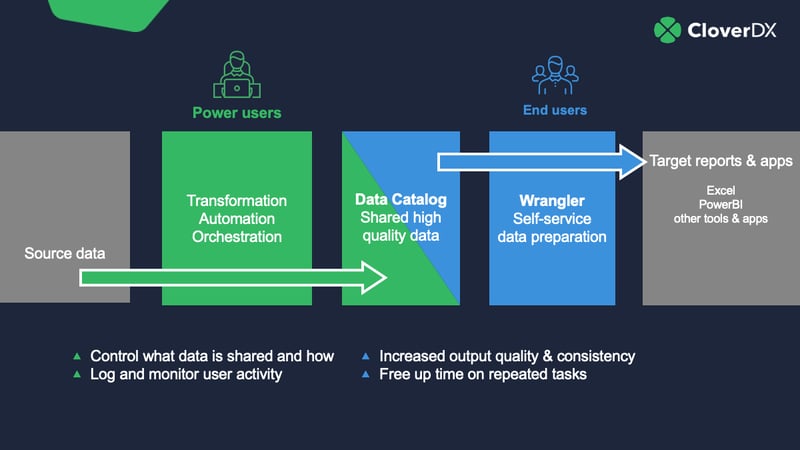“The essence of digital transformation is to become a data-driven organization, ensuring that key decisions, actions, and processes are strongly influenced by data-driven insights, rather than by human intuition.”
— Tomas Chamorro-Premuzic, Chief Innovation Officer at ManpowerGroup
Digital transformation continues to be a priority for senior executives, with one-third of CEOs naming technology as their top strategic focus. At the same time, investment in data and analytics capabilities continues to grow, with 82% of CEOs focusing resources on these areas.
Of course, these two priorities are deeply connected. Adopting digital technologies supports your ability to engage with data. And a data-driven picture of your organization helps direct your digital transformation efforts.
But in practice, these two priorities aren’t always aligned. As your digital transformation evolves, it’s easy for inconsistencies in your systems and processes to emerge. Teams may adopt a mix of tools to fit their needs without proper coordination. As a result, your data becomes difficult to access — and difficult to trust too.
In this post, we’ll explain why data accessibility should be a key part of your digital transformation strategy. But first, let’s look closer at the term itself.
Data availability vs. data accessibility: What’s the difference?
These two terms are often used interchangeably. However, there is a subtle but important distinction:
- Data availability is defined by the data your organization collects and stores. This will likely cover a wide variety of external and internal sources, from customer and product usage data to financial records and employee information.
- Data accessibility refers to how — or if — this data can be accessed by those who need it. What are the processes involved, and how long do they take? Do your teams even know what data is available in the first place?
If we make this distinction, we can quickly see that focusing on one without the other will limit your organization’s data maturity.
How they are connected
Let’s look at a specific example to make this clearer.
Your organization may gather huge amounts of customer data. Your product team has detailed usage data, while your marketing team has extensive web analytics. Your sales team understands what attracts new prospects, while your support team sees the issues your customers face.
All of this data is valuable for guiding your digital transformation. It can help you understand the problems you are trying to solve and identify metrics for success.
But having this data available is not enough to secure these benefits. This data may be:
- stored in multiple different systems, requiring time-consuming access requests
- managed by teams who are protective of their data and unwilling to share it
- inconsistent or filled with errors, requiring extensive preparation time
The result? Your data is available, but not accessible. And that means you can’t use it to support your digital transformation efforts.
Let’s look in more detail at how improving data accessibility can accelerate your digital transformation.
How data accessibility can accelerate your digital transformation
1. Better decision-making
A digital transformation is a complex and long-term process. At every stage, you’ll need to make decisions that shape your progress and set you up for success. You’ll need to ask:
- Which areas of the business should you prioritize?
- Which technologies will deliver the greatest impact?
- How do you allocate resource to keep the project moving without impacting your other business areas?
You can’t rely on intuition or industry best practices to answer these questions effectively. You need data.
With a clear, data-backed picture of your business, you can build a digital transformation strategy that aligns with your needs. And with access to relevant metrics, you can track your progress in real-time — and make adjustments as necessary.
2. A data-driven culture
“Why do some digital transformation (DT) efforts succeed and others fail? Fundamentally, it’s because most digital technologies provide possibilities for efficiency gains and customer intimacy. But if people lack the right mindset to change and the current organizational practices are flawed, DT will simply magnify those flaws.”
— Behnam Tabrizi, global business consultant and best-selling author
64% of CIOs identify culture as a key barrier to their digital ambitions. Without a willingness to adapt existing workflows and embrace new ways of working, you won’t deliver a successful digital transformation.
Data accessibility has a key role to play in driving cultural change. To facilitate this accessibility, consider supporting data self-service. This allows your teams to access validated datasets directly, without the need for access requests. As a result, it empowers your teams to engage with data more regularly. This won’t just improve their overall data literacy — it’ll also help them contribute to your digital transformation efforts.
With consistent access to key performance metrics, they can track the impact of any changes you implement. And with a clearer understanding of the benefits that a data-first approach brings, it’ll be easier to secure buy-in for your broader project.
3. Improved collaboration
A successful digital transformation requires a coordinated effort. If your teams aren’t aligned on best practices, you will struggle to deliver consistent change across your business.
This extends to your data practices. Data silos mean your teams can’t work together to develop innovative solutions. Nor can they identify areas of shared concern. Instead, they’ll focus solely on their own key deliverables and lose sight of the bigger picture.
Data accessibility means giving your teams easy access to all relevant data. If you do so, you’ll empower them to adopt shared goals and avoid pulling in opposite directions.
4. Reduced resource demands
Digital transformation places an added burden on your teams. They will need to learn new software and adapt to new processes. In some cases, they’ll have an active part in designing and delivering changes to your workflows.
These are time-consuming and mentally demanding tasks. And poor data accessibility will only add further friction. If your teams have to endure long waits for data or waste time on manual data preparation, their workloads can easily become unmanageable.
By empowering business users to access data directly, you can help reduce tedious workloads across the board. Your IT team needn’t field repeated access requests, and business users won’t have to wait around for the data they need.
The result? Employees across your organization have the time necessary to implement and adapt to your new digital processes.
5. Expanded automation
Automating repetitive manual tasks is one of the key benefits of digital transformation. And nowhere is this more obvious than in your data processes. From manual data entry to repetitive data preparation, automation can eliminate a range of bottlenecks.
But the impact isn’t all one way. While automation can improve your data processes, the reverse is also true.
Ensuring data is easily transferrable across applications provides a solid foundation for automating your business processes. If your data is siloed, you’re unlikely to be able to adopt automated reporting or automated customer onboarding.
And with the right tools in place, you can empower business users to build their own custom automations by recording and repeating their data preparation workflows. This means automation isn’t just implemented from the top down — it’s embedded at every level of your organization.
Accelerate your digital transformation with CloverDX
Data accessibility can deliver significant benefits for your digital transformation. But streamlining your data processes is no simple task. It requires C-suite buy-in, as well as a wider cultural shift.
But with the right tool in place, data accessibility needn’t detract from your wider efforts. With a data integration platform like CloverDX you can support data self-service and help democratize data access across your organization, ensuring valuable insights are accessible for everyone.
To discover how CloverDX can help your digital transformation success story, book a demo today.









